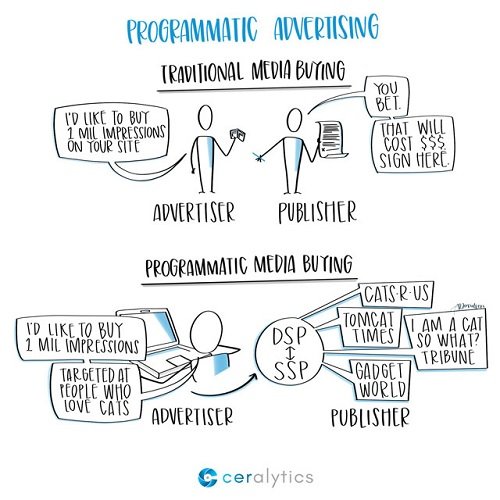What Is Programmatic Advertising?
Brandon Andersen, Chief Strategist, ceralyticsProgrammatic advertising sounds really fancy, but in reality, it has made media buying a much easier and more exact process than it used to be.Utilizing programmatic advertising, you can reach your target audiences across multiple publishers at once, without having to negotiate multiple contracts.Building off of the PESO post from last week (which was also published on Waxing Unlyrical if you missed it), a major component of paid media is something called programmatic advertising.It’s an impressive sounding term, and I bet you hear it thrown around a lot. But what is it? And how can you be utilizing it if you’re not already? Just like the graphic above suggests, programmatic advertising takes the middle-man out of placing ads and replaces it with automation. In traditional media buying, an advertiser would buy a certain number of impressions on a publisher’s site. These impressions are calculated as CPM, or cost per 1,000 impressions (M being the Roman numeral 1,000). The advertiser and publisher would then agree on the number of views for the ads, the CPM, and hammer out a contract.Advertisers would have to do this for every publisher they advertised on. That’s not very efficient.A new model emerged that combined the demand that advertisers have for getting their ads in front of specific audiences, and the supply of ad space that publishers have. This new model was programmatic advertising.Advertisers use a demand side platform (DSP) to choose which audiences they want to target and how much they are willing to pay to reach those audiences. Suppliers utilize a supply side platform (SSP) to show those buyers the inventory they have on their sites.Computer algorithms then match up advertisers with suppliers in real time, fulfilling a guaranteed order on both sides. Often, multiple publishers will be on the receiving end of the deal, spreading the advertiser’s message across many sites.No back and forth negotiating. No messy paperwork. Just results.Targeted advertisingAnother advantage of programmatic advertising is the ability to target specific demographics or audience interests.In the sketch above, the advertiser using programmatic advertising can determine that they only want their ads to reach cat lovers. Only publishers who have those audiences, such as Cats-R-Us, and TomCat Times, would then be matched to display those ads. But, because publishers understand a lot about their own audience’s interests, publishers like Gadget World could also be matched if certain subsets of their audiences are cat lovers too.Other forms of targeted advertising utilize existing data you have about your clients and/or prospects. Utilizing the information you know about your existing audiences, lookalike models can be made, showing that people who buy your product often exhibit certain interests or behaviors you can now target.The result is more focused advertising to the audience you truly want to reach.Next stepsUnlike a lot of the micro-lessons here, programmatic advertising, in its true sense, isn’t something you can easily pick up and run with. Many organizations defer this task to an agency or specialists within their organization.But understanding the fundamentals of programmatic advertising will help you have more informed conversations with your agency or in-house specialists when it comes to helping you develop and promote your own campaigns to specific audiences.
Just like the graphic above suggests, programmatic advertising takes the middle-man out of placing ads and replaces it with automation. In traditional media buying, an advertiser would buy a certain number of impressions on a publisher’s site. These impressions are calculated as CPM, or cost per 1,000 impressions (M being the Roman numeral 1,000). The advertiser and publisher would then agree on the number of views for the ads, the CPM, and hammer out a contract.Advertisers would have to do this for every publisher they advertised on. That’s not very efficient.A new model emerged that combined the demand that advertisers have for getting their ads in front of specific audiences, and the supply of ad space that publishers have. This new model was programmatic advertising.Advertisers use a demand side platform (DSP) to choose which audiences they want to target and how much they are willing to pay to reach those audiences. Suppliers utilize a supply side platform (SSP) to show those buyers the inventory they have on their sites.Computer algorithms then match up advertisers with suppliers in real time, fulfilling a guaranteed order on both sides. Often, multiple publishers will be on the receiving end of the deal, spreading the advertiser’s message across many sites.No back and forth negotiating. No messy paperwork. Just results.Targeted advertisingAnother advantage of programmatic advertising is the ability to target specific demographics or audience interests.In the sketch above, the advertiser using programmatic advertising can determine that they only want their ads to reach cat lovers. Only publishers who have those audiences, such as Cats-R-Us, and TomCat Times, would then be matched to display those ads. But, because publishers understand a lot about their own audience’s interests, publishers like Gadget World could also be matched if certain subsets of their audiences are cat lovers too.Other forms of targeted advertising utilize existing data you have about your clients and/or prospects. Utilizing the information you know about your existing audiences, lookalike models can be made, showing that people who buy your product often exhibit certain interests or behaviors you can now target.The result is more focused advertising to the audience you truly want to reach.Next stepsUnlike a lot of the micro-lessons here, programmatic advertising, in its true sense, isn’t something you can easily pick up and run with. Many organizations defer this task to an agency or specialists within their organization.But understanding the fundamentals of programmatic advertising will help you have more informed conversations with your agency or in-house specialists when it comes to helping you develop and promote your own campaigns to specific audiences.